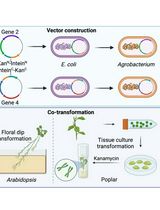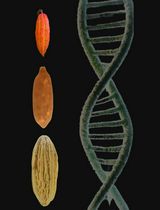- EN - English
- CN - 中文
Reduced Representation Bisulfite Sequencing in Maize
玉米中简化代表性亚硫酸氢盐测序
发布: 2018年03月20日第8卷第6期 DOI: 10.21769/BioProtoc.2778 浏览次数: 8579
评审: Renate WeizbauerAnnis Elizabeth RichardsonAnonymous reviewer(s)
Abstract
DNA methylation is an epigenetic modification that regulates plant development (Law and Jacobsen, 2010). Whole genome bisulfite sequencing (WGBS) is a state-of-the-art method for profiling genome-wide methylation patterns with single-base resolution (Cokus et al., 2008). However, for an organism with a large genome, e.g., the 2.1 Gb genome of maize, WGBS may be very expensive. Reduced representation bisulfite sequencing (RRBS) has been developed in mammalian studies (Smith et al., 2009). By digesting the genome with MspI with a size selection range of approximately 40-220 bp, CG-rich regions covering only ~1% of the human genome can be specifically sequenced. However, unlike mammalian genomes, plant genomes do not exhibit clear CpG islands. Therefore the original RRBS protocol is not suitable for plants. Accordingly, we developed an in silico pipeline to select specific enzymes to generate a region of interest (ROI)-enriched, e.g., promoter-enriched, reduced representation genome in plants (Hsu et al., 2017). By digesting the maize genome with MseI and selecting 40-300 bp segments, we sequenced about one-fourth of the maize genome while preserving 84.3% of the promoter information. The protocol has been successfully established in maize and can be broadly used in any genome. Our in silico pipeline is combined with the RRBS library preparation protocol, allowing for the computational analysis and experimental validation.
Keywords: Bisulfite sequencing (亚硫酸氢盐测序)Background
DNA methylation is a heritable epigenetic modification that plays an important role in many developmental processes of animals, plants and fungi by regulating gene expression and the chromatin structure (Law and Jacobsen, 2010). WGBS is a genome-wide scale method for profiling DNA methylation at single-base resolution, although high sequencing costs are required to achieve sufficient coverage (Cokus et al., 2008). In mammals, RRBS has been developed to specifically sequence CG-dense regions, e.g., CpG islands (Smith et al., 2009). In this protocol, we aimed to adapt RRBS for plants. To be specific, we developed an in silico pipeline (Figure 1) to performed enzyme selection by targeting specific genome regions to generate RRBS methylomes and provided an experimental validation protocol.
Our method has been successfully established in the maize genome, one of the major global crops, which has a 2.1 Gb genome (Hsu et al., 2017). In addition to its large size, 85% of the maize genome consists of various repetitive sequences (Schnable et al., 2009). This feature could cause multiple mapping, i.e., many short reads from sequencing, which need to be discarded. These characteristics make targeted bisulfite sequencing (BS-seq) more cost-effective. mCHH islands were found to be located upstream of transcription start sites (TSSs) with higher methylation level (Gent et al., 2013; Li et al., 2015). We therefore aimed to perform promoter-enriched RRBS in maize, and an in silico pipeline was developed for enzyme selection.
Our in silico pipeline currently has 85 pre-installed restriction enzymes. Users can easily append more enzymes. A genome FASTA file, refFlat annotation file, and repeat gff3 annotation file are the required input files to run this pipeline. ROIs, including promoters, exons, introns, splicing sites, repeats, UTRs and intergenic regions are pre-selected for enrichment analysis. As soon as the input files are prepared, users can run our pipeline to select ideal enzymes by typing simple commands. Users can also verify the prediction by performing RRBS library construction following the experimental protocol provided and performing sequencing.
Figure 1. Flowchart of maize RRBS in silico pipeline
Materials and Reagents
- Pipette tips
Note: Low retention tips are recommended. - 1.5 ml microcentrifuge tubes (Eppendorf, catalog number: 0030108051 )
- PCR tubes (Thermo Fisher Scientific, Applied BiosystemsTM, catalog number: A30588 )
- Clean razor blade
- Qubit dsDNA BR Assay Kit (Thermo Fisher Scientific, InvitrogenTM, catalog number: Q32850 ) (used to quantify double strand DNA in combination with Qubit Fluorometer)
- MseI (New England Biolabs, catalog number: R0525S ) (used to digest maize genomic DNA, CutSmart Buffer is included)
Note: The enzyme could be replaced according to the in silico enzyme selection result in Procedure A. - Agarose
Note: For the gel size selection, we recommend low melting point agarose. - TBE buffer (Thermo Fisher Scientific, InvitrogenTM, catalog number: 15581044 )
- AMPure XP (Beckman Coulter, catalog number: A63881 )
- Absolute ethanol
Note: To dilute, use DNase/RNase-free distilled water. - 1 M Tris-HCl (Thermo Fisher Scientific, InvitrogenTM, catalog number: 15568025 )
Note: To dilute, use DNase/RNase-free distilled water. - NEBuffer 2 (New England Biolabs, catalog number: B7002S )
- Klenow Fragment (3’→5’ exo-) (New England Biolabs, catalog number: M0212S ) (used to end-repair and A-tail DNA)
- T4 DNA Ligase (New England Biolabs, catalog number: M0202S , T4 DNA ligation buffer is included) (used to ligate sequencing adaptors)
- 100-bp DNA ladder
- QIAquick Gel Extraction Kit (QIAGEN, catalog numbers: 28704 , 28706 )
- EpiTect Fast Bisulfite Conversion Kit (QIAGEN, catalog number: 59824 )
Note: Keep this kit at an appropriate temperature according to the manufacturer’s guide. - TruSeq DNA LT Sample Prep Kit (Illumina, catalog number: FC-121-2001 )
- PfuTurbo DNA Polymerase (Agilent Technologies, catalog number: 600250 )
- DNase/RNase-free distilled water (Thermo Fisher Scientific, InvitrogenTM, catalog number: 10977015 )
- Deoxynucleotide (dNTP) Solution Set (New England Biolabs, catalog number: N0446S )
- MinElute PCR Purification Kit (QIAGEN, catalog number: 28004 )
- 10 mM dNTP mix (see Recipes)
- 5x RRBS dNTP mix (see Recipes)
Equipment
- Pipettes:
- Thermo Fisher Scientific, Thermo ScientificTM, model: P5000, catalog number: 4641110N
- Thermo Fisher Scientific, Thermo ScientificTM, model: P1000, catalog number: 4641100N
- Thermo Fisher Scientific, Thermo ScientificTM, model: P300, catalog number: 4641090N
- Thermo Fisher Scientific, Thermo ScientificTM, model: P200, catalog number: 4641080N
- Thermo Fisher Scientific, Thermo ScientificTM, model: P100, catalog number: 4641070N
- Thermo Fisher Scientific, Thermo ScientificTM, model: P20, catalog number: 4641060N
- Thermo Fisher Scientific, Thermo ScientificTM, model: P10, catalog number: 4641030N
- Thermo Fisher Scientific, Thermo ScientificTM, model: P2, catalog number: 4641010N
- Thermo Fisher Scientific, Thermo ScientificTM, model: P5000, catalog number: 4641110N
- Qubit 2.0 Fluorometer (Thermo Fisher Scientific, Invitrogen, model: Qubit® 2.0 Fluorometer , catalog number: Q32866)
- Heating block (Eppendorf, model: ThermoMixer comfort , catalog number: 5355000011)
- Incubator (Only Science, Firstek, model: S300 )
- Thermocycler
- Thermo Fisher Scientific, Applied BiosystemsTM, model: GeneAmpTM PCR System 9700 , catalog number: 4413750
- Bio-Rad Laboratories, model: T100TM Thermal Cycler, catalog number: 1861096
- Thermo Fisher Scientific, Applied BiosystemsTM, model: GeneAmpTM PCR System 9700 , catalog number: 4413750
- Centrifuge
- Eppendorf, model: Centrifuge MiniSpin® plus , catalog number: 5453000011
- Eppendorf, model: Centrifuge 5424 , catalog number: 5424000410
- GYROZEN, model: 1730R
- Eppendorf, model: Centrifuge MiniSpin® plus , catalog number: 5453000011
- Magnetic stand
Software
- System requirements: Linux/Unix or Mac OS, python 2.7+, R 3.2.0
- Python and R scripts and a tutorial are available at: https://gitlab.com/fmhsu0114/maize_RRBS
Procedure
文章信息
版权信息
© 2018 The Authors; exclusive licensee Bio-protocol LLC.
如何引用
Hsu, F., Wang, C. R. and Chen, P. Y. (2018). Reduced Representation Bisulfite Sequencing in Maize. Bio-protocol 8(6): e2778. DOI: 10.21769/BioProtoc.2778.
分类
系统生物学 > 表观基因组学 > DNA 甲基化
植物科学 > 植物分子生物学 > DNA
分子生物学 > DNA > DNA 测序
您对这篇实验方法有问题吗?
在此处发布您的问题,我们将邀请本文作者来回答。同时,我们会将您的问题发布到Bio-protocol Exchange,以便寻求社区成员的帮助。
提问指南
+ 问题描述
写下详细的问题描述,包括所有有助于他人回答您问题的信息(例如实验过程、条件和相关图像等)。
Share
Bluesky
X
Copy link














